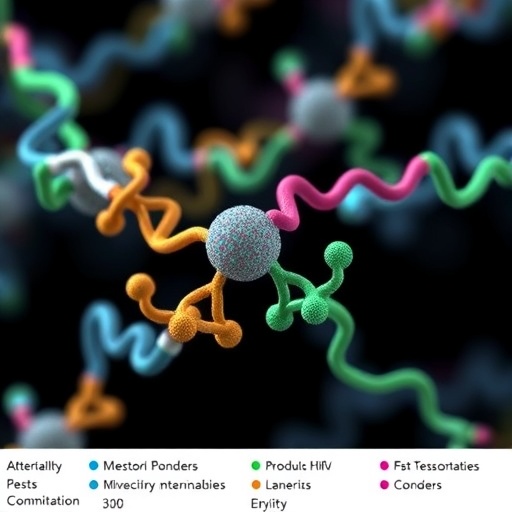A groundbreaking discovery by researchers at Kyoto University has unveiled a new player in the intricate world of DNA architecture regulation within spermatogonial stem cells (SSCs). This novel complex, termed STAG3-cohesin, redefines our understanding of how mitotic cohesin complexes orchestrate the unique chromatin landscape necessary for sperm development. Traditionally, STAG3 was believed to function exclusively during meiosis, the specialized cell division process that produces gametes. However, this new research overturns that long-standing assumption by demonstrating STAG3’s active role within mitotically dividing SSCs, marking a paradigm shift in cell biology and reproductive science.
Every cell in the human body harbors an identical DNA blueprint, yet the diversity in cell types arises from the distinct ways DNA is folded, packaged, and regulated. Within the nucleus, approximately two meters of DNA strand must be intricately folded to fit into a microscopic space, a process meticulously organized into three-dimensional domains delineated by boundary regions known as insulation. These boundaries prevent cross-talk between different genetic elements, ensuring precise gene expression patterns. Cohesin complexes, multi-protein rings known for holding sister chromatids together during cell division, have recently gained recognition as vital architects of these boundaries, mediating chromatin looping and genome organization.
Before this study, two primary cohesin complexes were characterized: mitotic cohesins comprising STAG1 or STAG2 paired with RAD21, active during the cell cycles that produce identical daughter cells; and meiotic cohesins containing STAG3 partnered with REC8 or RAD21L, operative during gamete formation. However, SSCs, the stem cells responsible for sustaining spermatogenesis, seemed to challenge these categorizations. These cells feature uniquely weak DNA boundary structures, an unusual characteristic that hinted at the possibility of unexplored regulatory mechanisms.
In pursuit of elucidating the molecular underpinnings of SSC-specific DNA organization, the Kyoto University team employed state-of-the-art immunoprecipitation followed by mass spectrometry to map cohesin components within in vitro cultured SSCs. Their results were startling: instead of associating with STAG1 or STAG2 as conventional mitotic cells do, RAD21 partnered predominantly with STAG3. This unexpected pairing revealed a heretofore unknown mitotic cohesin complex, now named STAG3-cohesin, shattering the dogma that positioned STAG3’s function solely within meiotic contexts.
To interrogate the functional consequences of this novel complex, the scientists engineered genetically modified SSC lines. One variant was deficient in STAG3, while another expressed STAG3 exclusively, lacking STAG1 and STAG2. Through meticulous chromatin conformation analyses, the team demonstrated that STAG3-cohesin is responsible for the distinctive weak boundary formation in SSC chromatin architecture. Crucially, SSCs devoid of STAG3 failed to transition efficiently from stem cell status to differentiated germ cells, indicating that STAG3 not only sculpts the nucleome but is indispensable for proper sperm development.
Extending beyond basic biology, the implications of STAG3’s mitotic role ripple into human health and disease. Leveraging extensive transcriptomic datasets, the researchers established that STAG3 exhibits high expression levels in human immune B cells and, notably, in B-cell lymphomas — cancers derived from malignant B lymphocytes. Functional assays revealed that targeted inhibition of STAG3 in these cancer cells significantly impeded their proliferative capacity in vitro, indicating a promising therapeutic target in oncology.
This discovery of STAG3-cohesin as a distinct mitotic complex with dual roles in germline development and cancer pathophysiology invites a reevaluation of cohesin biology. Unlike classical cohesins, which form robust DNA boundaries, STAG3-cohesin creates weaker, more flexible insulation zones, potentially facilitating the dynamic chromatin remodeling essential for SSC differentiation. This finding advances the understanding of how subtle modulation of chromatin topology can influence cell fate decisions, particularly at the critical juncture between mitosis and meiosis.
The stakes of this research are profound. Male infertility remains a global challenge with complex underlying causes, many of which relate to defects in germ cell development. Illuminating the role of STAG3-cohesin offers a tangible molecular mechanism that could underpin certain infertility cases linked to SSC dysfunction. Furthermore, the connection of STAG3 to B-cell lymphoma progression opens novel avenues for cancer research targeting cohesin complexes, a class of proteins not traditionally exploited in cancer therapeutics.
Beyond immediate clinical applications, the study catalyzes fundamental questions about genome regulation. How does the presence of STAG3 in mitotic cells alter the cohesin-mediated chromatin loop formation? What regulatory pathways control the switch between the usage of STAG3-cohesin and canonical cohesins during stem cell differentiation? Addressing these will be pivotal in decoding the complex choreography of the male germline nucleome.
The Kyoto University team, led by Professor Mitinori Saitou, combined sophisticated biochemical techniques, genetic engineering, and computational biology to dissect the chromatin landscape of SSCs. Their integrative approach exemplifies how interdisciplinary methods can unravel previously inaccessible layers of cellular regulation. Published in the prestigious journal Nature Structural & Molecular Biology, this study sets a new standard for investigations into the molecular architecture of stem cells.
Looking forward, the scientific community anticipates that research into STAG3’s functions will expand into other cell types, potentially revealing broader roles for this cohesin variant in human development and disease. Its unexpected presence and function in immune cells hint at an intricate network of genome regulation that transcends traditional boundaries of cell identity and division modes.
In sum, the revelation of STAG3-cohesin reshapes our conception of the mitotic machinery within spermatogonial stem cells, linking genome structure remodeling directly to stem cell fate and fertility. At the intersection of structural biology, stem cell research, and oncology, this discovery heralds a new chapter in understanding the dynamic interplay between chromatin architecture and cellular function, with promising translational potential in medicine.
Subject of Research: Cells
Article Title: The mitotic STAG3–cohesin complex shapes male germline nucleome
News Publication Date: August 25, 2025
Web References:
References:
- Saitou, M., Nagano, M., Hu, B. et al. The mitotic STAG3–cohesin complex shapes male germline nucleome. Nature Structural & Molecular Biology (2025).
Keywords: Gametogenesis, Chromatin




